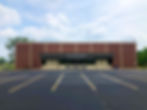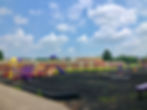
Grades K-2

Grades 3-5

Playground at Bell Creek Intermediate

Grades K-2
How New Developments Affect The School's Income
This one took a little figuring out. What really helped us to make sense of this question was the understanding that there’s always been some level of taxes applied to the land. Prior to being used by the developer most of the developments were zoned agricultural. This land type is taxed a little differently than residential, to help support small farms, but the same outside and inside millage is being applied. When it’s re-zoned for residential use, the tax formula that applies to farmland switches over to the tax formula for housing. There is a tax increase to raise them to the correct level for the land use but it’s very little because raw land isn’t worth near as much as developed land. Once a house is built there is another increase in taxes to bring the tax value of the parcel up to the current tax amount that would apply to it. So there is new money being added a step at a time, with the largest bump being the one after a home has been built.
This makes sense for inside millage, but isn’t outside millage fixed? It is, but only for any kind of reappraisal. When the value changes in the existing properties, those numbers don’t change how much the public services get because the houses already have an appraised value. When new homes are built and assessed for the first time, those appraisals are added to the current tax district’s outside millage at whatever the current effective rates are. Here’s an entirely hypothetical example, as we don’t know the exact amounts for any real, specific development. Right now, the 5.7 mil levy on the coming ballot is said to total 3.3 million. If a new development is added after the levy passes, the levy is still 5.7 mil, but now it totals 3.5 million instead. The taxes would remain the same for everyone. This is the only time outside millage can increase without passing another levy.
An increase is good, right? Well, maybe. There’s more to this equation than just a financial boost. How many school-age children that will attend BSS move into the new housing has a major impact on whether or not that increase has any effect at all. Every new house represents a small amount of additional revenue, while every new student is an additional expenditure. If only a few students move into the development, and it ends up being mostly childless, then the tax bump produced by these properties could give BSS a small financial increase. However, if the new housing is attractive to families with school-age kids because the BSS school district is well rated and the overall taxes are lower than other cities with well-rated schools, the new properties could, in fact, worsen the school’s financial stability.
Let’s look at some numbers to explain how this works. A quick google search turned up this article in the Dayton Daily News about possible future housing in Sugarcreek Township. We don’t know if the plans for these developments went through or if they’re being sold at the prices mentioned but since this is intended to be an example only, we’ll use the values that were quoted.

-
Sugarcreek Township is paying a total of 76.364660 mils in 2019. 41.665122 mils of that are going to the school. Divide the schools portion by the total and you get the percentage going to the school, just shy of 55%. We'll round to 55% for simpler math.
-
We'll assume the land was valued at $55,000 to $70,000 a parcel before building. That means there is $1,345.30 to $1,712.20 in taxes already being applied. (as per the auditor's tax estimator).
-
Houses appraised between $325,000 and $400,000 would generate between $7,765.30 and $9,557.29 with Owner Occupancy credit applied (as per the auditor’s tax estimator).
-
So prior to building, the schools got between $739.92 and $941.71 a year from the development. After building, the new amount the schools will get is between $4270.92 and $5,256.51 per property, per year.
-
Subtract out what the school was already getting and you get the new money. $3,531 to $4,314.80.
-
Here’s where the student body comes into play. The cost of educating a single student, as per the BSS current 5-year financial forecast is $10,970, nearly $1,000 less than the state average per student of $11,900. (Divide their total expenditures by the current student body. This does not include the preschool even though BSS is paying for a portion of that as well.)
-
The state only gives BSS $3,195 per student, though a portion students have some additional funding provided by the state.
-
If they’re putting in 189 new homes, like the article talks about, let’s estimate the amount the school will get in ‘new’ money. Which is income generated above the income the school was already getting prior to the development's completion.
-
Start by finding the overall average taxes for the development. Add $3,531 to $4,314.80.
-
Then divide that by 2 to get the average, $3,922.90.
-
Now, multiply that by the number of new homes, 189, which gives us $741,428.10 in new money for the school from that housing development.
-
Let’s see how much our local property taxes are covering per student. $10,970 - $3,195 = $7,775.
-
So how many students would that $741,428.10 cover per year?
-
$741,428.10 divided by $7,775 is 95 students.
-
So that development supports 95 or fewer students. If more students than that move into the subdivision, BSS will have more children than the new development will cover the cost of. Fewer students and the school will have a little extra funding, but what that bump looks like is entirely dependent on where under 95 mark the number of students falls.
-
Let’s assume a logical, possible scenario. Half the houses have school-aged kids attending BSS in them. The current average family size has 1.9 kids. After rounding up, that totals 180 new students, which is nearly double the amount that the 'new' money going to the school from the development can sustain.
-
So let's see what happens if only a 1/4 of the homes have school age kids move in. If we round up, that's about 90 kids.
-
So how much ‘extra’ is going to the schools?
-
Let’s find out how much the new students will cost first. $7,775 X 90 = $699,750.
-
Subtract that total from the taxes coming in from the development. $741,428.10 - $699,750 = $41,498.10. This represents a 0.0013 percent raise.
If the median income in Bellbrook is around $75,000, that’s like having $97.50 total added to the yearly income. An extra $8.13 a month. That would not really help with monthly bills, would it? The school is the same. They’d be able to use the overage for sure, but would it represent a huge influx of new money in the overall picture of their budget? Not at all.

